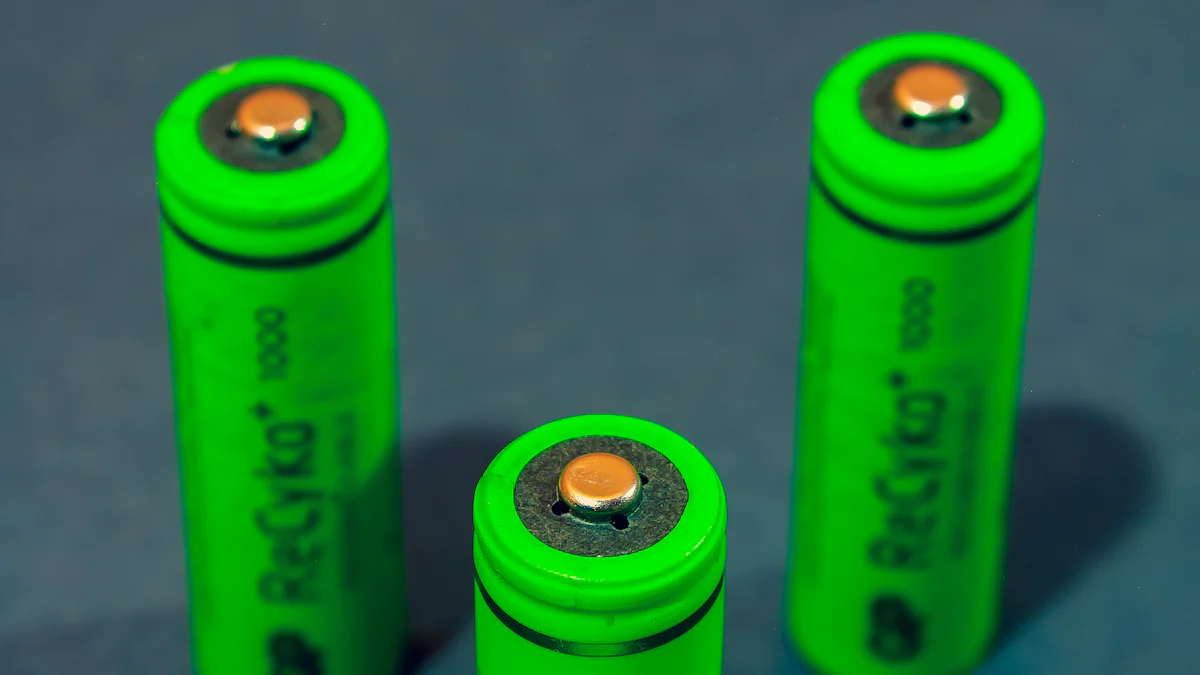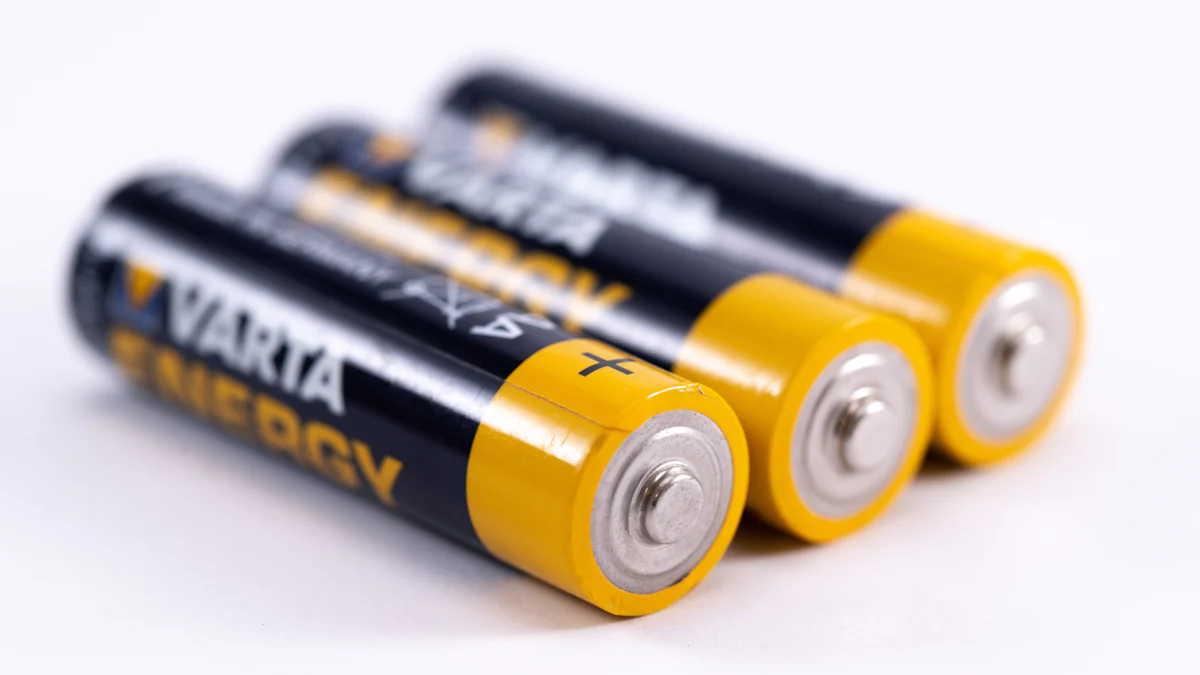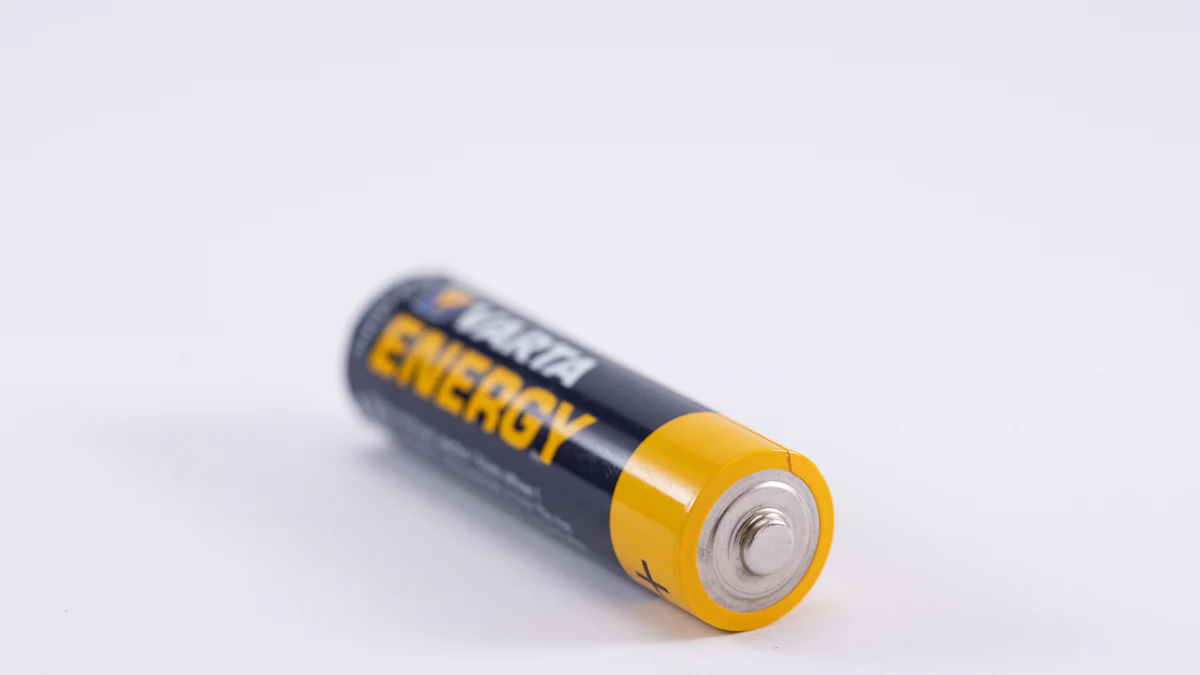
Alkaline batteries made a significant impact on portable power when they emerged in the mid-20th century. Their invention, credited to Lewis Urry in the 1950s, introduced a zinc-manganese dioxide composition that offered longer life and greater reliability than earlier battery types. By the 1960s, these batteries became household staples, powering everything from flashlights to radios. Today, over 10 billion units are produced annually, meeting the growing demand for efficient energy solutions. Advanced manufacturing hubs worldwide ensure consistent quality, with materials like zinc and manganese dioxide playing a pivotal role in their performance.
Key Takeaways
- Alkaline batteries, invented by Lewis Urry in the 1950s, revolutionized portable power with their longer life and reliability compared to earlier battery types.
- The global production of alkaline batteries is concentrated in countries like the United States, Japan, and China, ensuring high-quality output to meet consumer demand.
- Key materials such as zinc, manganese dioxide, and potassium hydroxide are essential for the performance of alkaline batteries, with advancements in material science enhancing their efficiency.
- Modern manufacturing processes utilize automation to improve precision and speed, resulting in batteries that last longer and perform better than their predecessors.
- Alkaline batteries are non-rechargeable and best suited for low to moderate-drain devices, making them a practical choice for everyday household items.
- Sustainability is becoming a priority in the alkaline battery industry, with manufacturers adopting eco-friendly practices and materials to meet consumer preferences.
- Proper storage and disposal of alkaline batteries can extend their shelf life and minimize environmental impact, highlighting the importance of responsible usage.
The Historical Origins of Alkaline Batteries

The Invention of Alkaline Batteries
The story of alkaline batteries began with a groundbreaking invention in the late 1950s. Lewis Urry, a Canadian chemical engineer, developed the first zinc-manganese dioxide alkaline battery. His innovation addressed a critical need for longer-lasting and more reliable power sources. Unlike earlier batteries, which often failed under continuous use, Urry’s design offered superior performance. This advancement spurred a revolution in portable consumer devices, enabling the development of products like flashlights, radios, and toys.
In 1959, alkaline batteries made their debut in the market. Their introduction marked a turning point in the energy industry. Consumers quickly recognized their cost-effectiveness and efficiency. These batteries not only lasted longer but also provided consistent power output. This reliability made them an instant favorite among households and businesses alike.
“The alkaline battery is one of the most significant advancements in portable power,” said Urry during his lifetime. His invention laid the foundation for modern battery technology, influencing countless innovations in consumer electronics.
Early Production and Adoption
The early production of alkaline batteries focused on meeting the growing demand for portable energy solutions. Manufacturers prioritized scaling up production to ensure widespread availability. By the early 1960s, these batteries had become household staples. Their ability to power a wide range of devices made them indispensable in daily life.
During this period, companies invested heavily in refining the manufacturing process. They aimed to enhance the performance and durability of alkaline batteries. This commitment to quality played a crucial role in their rapid adoption. By the end of the decade, alkaline batteries had established themselves as the preferred choice for consumers worldwide.
The success of alkaline batteries also influenced the development of consumer electronics. Devices that relied on portable power became more advanced and accessible. This symbiotic relationship between batteries and electronics drove innovation in both industries. Today, alkaline batteries remain a cornerstone of portable power solutions, thanks to their rich history and proven reliability.
Where Are Alkaline Batteries Made Today?
Major Manufacturing Countries
Alkaline batteries made today come from a variety of global manufacturing hubs. The United States leads production with companies like Energizer and Duracell operating advanced facilities. These manufacturers ensure high-quality output to meet domestic and international demand. Japan also plays a significant role, with Panasonic contributing to the global supply through its state-of-the-art factories. South Korea and China have emerged as key players, leveraging their industrial capabilities to produce large volumes efficiently.
In Europe, countries such as Poland and the Czech Republic have become prominent manufacturing centers. Their strategic locations allow easy distribution across the continent. Developing nations like Brazil and Argentina are also entering the market, focusing on regional demand. This global network ensures that alkaline batteries remain accessible to consumers worldwide.
“The global production of alkaline batteries reflects the interconnected nature of modern manufacturing,” industry experts often note. This diversity in production locations strengthens the supply chain and supports consistent availability.
Factors Influencing Production Locations
Several factors determine where alkaline batteries are made. Industrial infrastructure plays a crucial role. Countries with advanced manufacturing capabilities, such as the United States, Japan, and South Korea, dominate the market. These nations invest heavily in technology and automation, ensuring efficient production processes.
Labor costs also influence production locations. China, for instance, benefits from a combination of skilled labor and cost-effective operations. This advantage allows Chinese manufacturers to compete on both quality and price. Proximity to raw materials is another critical factor. Zinc and manganese dioxide, essential components of alkaline batteries, are more accessible in certain regions, reducing transportation costs.
Government policies and trade agreements further shape production decisions. Countries offering tax incentives or subsidies attract manufacturers looking to optimize costs. Additionally, environmental regulations impact where factories are established. Nations with stringent policies often require advanced technologies to minimize waste and emissions.
This combination of factors ensures that alkaline batteries made in different parts of the world meet diverse consumer needs. The global distribution of production facilities highlights the industry’s adaptability and commitment to innovation.
Materials and Processes in Alkaline Battery Production

Key Materials Used
Alkaline batteries rely on a carefully selected combination of materials to deliver their reliable performance. The primary components include zinc, manganese dioxide, and potassium hydroxide. Zinc serves as the anode, while manganese dioxide functions as the cathode. Potassium hydroxide acts as the electrolyte, facilitating the flow of ions between the anode and cathode during operation. These materials are chosen for their ability to store energy densely and maintain stability under various conditions.
Manufacturers often enhance the cathode mix by incorporating carbon. This addition improves conductivity and boosts the battery’s overall efficiency. The use of high-purity materials ensures minimal leakage risk and extends the battery’s shelf life. Advanced alkaline batteries made today also feature optimized material compositions, allowing them to store more energy and last longer than earlier versions.
The sourcing of these materials plays a critical role in production. Zinc and manganese dioxide are widely available, making them cost-effective choices for large-scale manufacturing. However, the quality of these raw materials directly impacts the battery’s performance. Leading manufacturers prioritize sourcing from reliable suppliers to maintain consistent quality.
The Manufacturing Process
The production of alkaline batteries involves a series of precise steps designed to ensure efficiency and reliability. The process begins with the preparation of the anode and cathode materials. Zinc powder is processed to create the anode, while manganese dioxide is mixed with carbon to form the cathode. These materials are then shaped into specific configurations to fit the battery’s design.
Next, the electrolyte solution, composed of potassium hydroxide, is prepared. This solution is carefully measured and added to the battery to enable ion flow. The assembly stage follows, where the anode, cathode, and electrolyte are combined within a sealed casing. This casing is typically made of steel, providing durability and protection against external factors.
Automation plays a significant role in modern battery manufacturing. Fully automated production lines, like those used by Johnson New Eletek Battery Co., Ltd., ensure precision and consistency. These lines handle tasks such as material mixing, assembly, and quality control. Advanced machinery minimizes human error and enhances production speed.
Quality control is the final and most crucial step. Each battery undergoes rigorous testing to verify its performance and safety. Manufacturers test for factors such as energy output, leakage resistance, and durability. Only batteries that meet strict standards proceed to packaging and distribution.
The continuous improvement of manufacturing techniques has led to significant advancements in alkaline battery technology. Researchers have developed methods to increase energy density and extend cycle life, ensuring that alkaline batteries remain a reliable choice for consumers worldwide.
The Evolution of Alkaline Battery Production
Technological Advancements
The production of alkaline batteries has undergone remarkable transformations over the years. I have observed how advancements in technology have consistently pushed the boundaries of what these batteries can achieve. Early designs focused on basic functionality, but modern innovations have revolutionized their performance and efficiency.
One of the most significant breakthroughs involves the use of enhanced cathode materials. Manufacturers now incorporate higher amounts of carbon into the cathode blend. This adjustment increases conductivity, resulting in batteries with longer life cycles and improved power efficiency. These advancements not only meet consumer demands but also drive market growth.
Another key development lies in the optimization of energy density. Modern alkaline batteries store more energy in smaller sizes, making them ideal for compact devices. Researchers have also improved the shelf life of these batteries. Today, they can last up to ten years without significant performance degradation, ensuring reliability for long-term storage.
Automation has played a pivotal role in refining the manufacturing process. Fully automated production lines, like those at Johnson New Eletek Battery Co., Ltd., ensure precision and consistency. These systems minimize errors and enhance production speed, allowing manufacturers to meet global demand efficiently.
“The emergence of new generation alkaline battery technology presents enormous potential and opportunities for the battery industry,” according to recent studies. These advancements not only reshape how we use batteries but also support progress in renewable energy and electrification.
Global Trends in the Industry
The alkaline battery industry continues to evolve in response to global trends. I have noticed a growing emphasis on sustainability and environmental responsibility. Manufacturers are adopting eco-friendly practices, such as reducing waste during production and sourcing materials responsibly. These efforts align with the increasing consumer preference for sustainable products.
The demand for high-performance batteries has also influenced industry trends. Consumers expect batteries that last longer and perform consistently under various conditions. This expectation has driven manufacturers to invest in research and development. Innovations in material science and production techniques ensure that alkaline batteries remain competitive in the market.
Globalization has further shaped the industry. Manufacturing hubs in countries like the United States, Japan, and China dominate production. These regions leverage advanced technology and skilled labor to produce high-quality batteries. At the same time, emerging markets in South America and Southeast Asia are gaining traction, focusing on regional demand and affordability.
The integration of alkaline batteries into renewable energy systems marks another significant trend. Their reliability and energy density make them suitable for backup power and off-grid applications. As renewable energy adoption grows, alkaline batteries play a crucial role in supporting these systems.
Alkaline batteries have shaped the way we power devices, offering reliability and versatility since their invention. Their global production spans major hubs in the United States, Asia, and Europe, ensuring accessibility for consumers everywhere. The evolution of materials like zinc and manganese dioxide, combined with advanced manufacturing processes, has enhanced their performance and longevity. These batteries remain indispensable due to their high energy density, long shelf life, and ability to operate in diverse environments. As technology advances, I believe alkaline batteries will continue to meet the growing demand for efficient and sustainable energy solutions.
FAQ
How long can I store alkaline batteries?
Alkaline batteries, known for their long shelf life, can typically be stored for up to 5 to 10 years without significant performance loss. Their non-rechargeable nature ensures they retain energy effectively over time. To maximize storage life, I recommend keeping them in a cool, dry place away from direct sunlight or extreme temperatures.
Are alkaline batteries rechargeable?
No, alkaline batteries are non-rechargeable. Attempting to recharge them can lead to leakage or damage. For reusable options, I suggest exploring rechargeable battery types like nickel-metal hydride (NiMH) or lithium-ion batteries, which are designed for multiple charging cycles.
What devices work best with alkaline batteries?
Alkaline batteries perform exceptionally well in low to moderate-drain devices. These include remote controls, flashlights, wall clocks, and toys. For high-drain devices like digital cameras or gaming controllers, I recommend using lithium or rechargeable batteries for optimal performance.
Why do alkaline batteries sometimes leak?
Battery leakage occurs when the internal chemicals react due to prolonged use, over-discharge, or improper storage. This reaction can cause potassium hydroxide, the electrolyte, to seep out. To prevent leakage, I advise removing batteries from devices not in use for extended periods and avoiding mixing old and new batteries.
How can I safely dispose of alkaline batteries?
In many regions, alkaline batteries can be disposed of with regular household waste since they no longer contain mercury. However, I encourage checking local regulations, as some areas offer recycling programs for batteries. Recycling helps reduce environmental impact and supports sustainable practices.
What makes alkaline batteries different from other types?
Alkaline batteries use zinc and manganese dioxide as their primary materials, with potassium hydroxide as the electrolyte. This composition provides a higher energy density and longer shelf life compared to older battery types like zinc-carbon. Their affordability and reliability make them a popular choice for everyday use.
Can alkaline batteries be used in extreme temperatures?
Alkaline batteries operate best within a temperature range of 0°F to 130°F (-18°C to 55°C). Extreme cold can reduce their performance, while excessive heat may cause leakage. For devices exposed to harsh conditions, I recommend lithium batteries, which handle temperature extremes more effectively.
How do I know when an alkaline battery needs replacing?
A device powered by alkaline batteries will often show signs of reduced performance, such as dimming lights or slower operation, when the batteries are near depletion. Using a battery tester can provide a quick and accurate way to check their remaining charge.
Are there eco-friendly alternatives to alkaline batteries?
Yes, rechargeable batteries like NiMH and lithium-ion are more environmentally friendly options. They reduce waste by allowing multiple uses. Additionally, some manufacturers now produce alkaline batteries with reduced environmental impact, such as those made with recycled materials or lower carbon footprints.
What should I do if an alkaline battery leaks?
If a battery leaks, I recommend wearing gloves to clean the affected area with a mixture of water and vinegar or lemon juice. This neutralizes the alkaline substance. Dispose of the damaged battery properly and ensure the device is thoroughly cleaned before inserting new batteries.
Post time: Dec-27-2024




